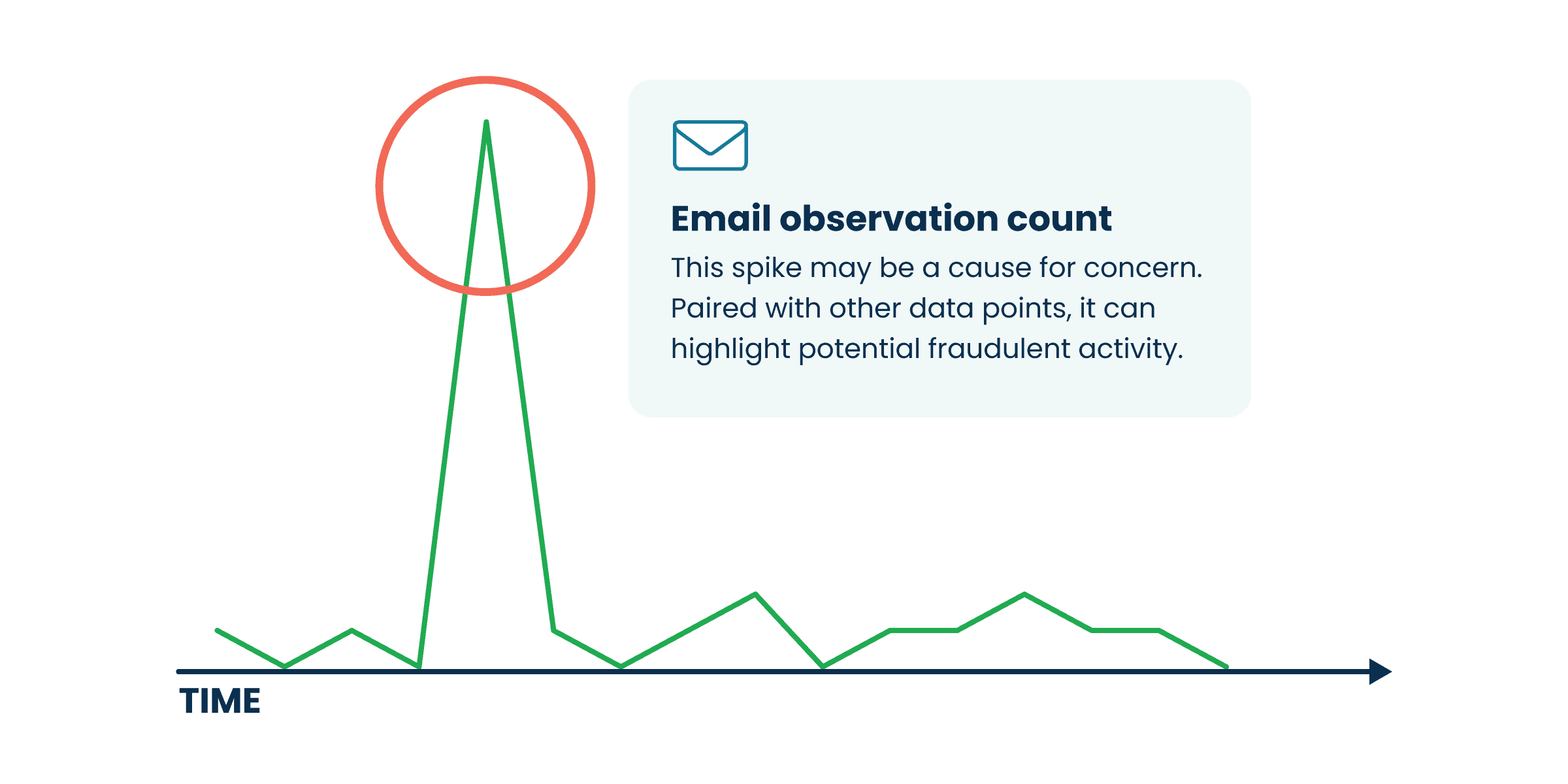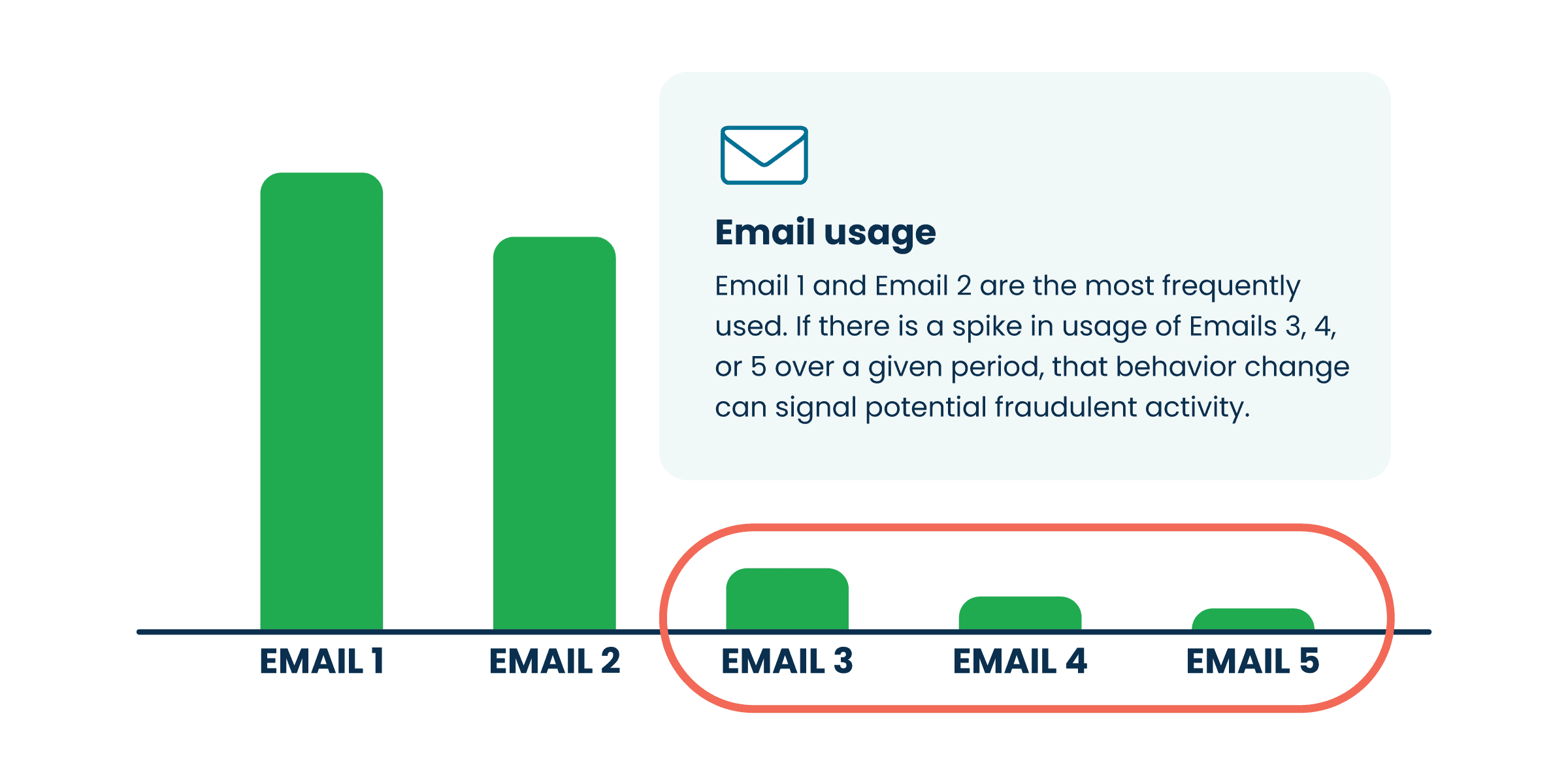Fideo Blog: Product: Signals

Announcing the Beta Release of Signal Patterns: Revolutionizing Fraud Detection
We are excited to unveil the beta release of our Signal Patterns feature! This innovative addition to the Fideo Intelligence Platform marks the debut of Fideo’s Patterns series, poised to revolutionize fraud detection and identity verification across industries.
A Game-Changer in Fraud Detection
Imagine you’re running a financial fraud detection platform. Your traditional data sources are limited: credit bureaus provide emails with their first-seen date and an associated name. This leaves you struggling to track email usage frequency across different timeframes, with significant blind spots in the history of these emails outside your client base.
Signal Patterns sets itself apart by offering unprecedented insight, providing not only a detailed history of an email’s activity outside your client universe—whether hourly, daily, weekly, or even yearly—but also valuable context about the types of activities driving this usage. No other data source offers this level of granular tracking of email behavior.
Consider this recent case: Your platform detected multiple third-party account creations tied to a single email address in under an hour. Normally, this behavior would have gone completely undetected since it occurred outside your client network. But with Signal Patterns, your platform instantly identified the suspicious spike in activity. This capability enabled real-time, accurate identification of a coordinated fraud attempt involving fake accounts and phishing schemes, allowing your clients to stop the threat before it could escalate.
What makes Signal Patterns stand out is its ability to detect patterns and anomalies that would otherwise go unnoticed. By identifying trends, such as sudden spikes in email usage, fraud teams are provided with actionable insights that no other external data set delivers. This level of detail is indispensable in staying ahead of evolving fraud tactics, offering unmatched protection in the industry.
The Evolution of Signal Patterns
Our Journey
The team behind the Fideo Intelligence Platform has observed the usage of emails and identity fragments for nearly a decade. We’ve made it a point to be part of diverse data sets and workflows, ensuring our system is well-informed about how these identities are used in the real world.
As we expanded our identity graph and anomaly detection systems, we realized we were observing a real-time feed of how emails are actually used in the wild. This information became a core ingredient in helping to detect proof of life and activity, as well as informing our models of typical behavior versus anomalies. While the industry refers to these signals around frequency and recency as “velocity,” our rich data network allows us to expand on this concept by uncovering insights into the type of activity.
We aptly named this context of the activity “Patterns.”
Drawing on years of expertise in identity intelligence, we’ve upgraded our platform to provide valuable email signals with first-seen and last-seen timestamps. These signals validate proof of life and proof of activity, as well as provide historical context on email signals—whether an email has been around for years or was just created, as well as how recently it has been seen. By identifying these Patterns around identities, we can empower organizations to see a deeper, wider view of a person’s identity.
What are Signal Patterns?
Signal Patterns is a powerful new feature that provides metadata around emails, helping you identify patterns that could be associated with fraud.
Let’s dive into a real-world scenario to illustrate its capabilities.
In the chart below, you can see a clear spike in observations of a given email over time. This spike may be a cause for concern. Paired with other data points, it can highlight potential fraudulent activity.

How Signal Patterns Works
There are three different ways you can leverage signal data:
- User-defined Time Series: Time series can highlight anomalies in patterns with down-to-the-minute resolution (up to two years), as shown in our visualizations.
- Historical Summaries: A historical summary counts how many times an email has been seen and from how many sources in the past hour, day, week, month, six months, and year.
- Integration with Signals: Signal Patterns become even more powerful when integrated into our existing Signals product, highlighting which emails are used more often than others.
API Example—Time Series
If you want to see the usage of a given email over the last six hours:
HTTP POST Request to /beta/signals/patterns/timeseries
{
"email" : "[email protected]",
"count" : 6,
"interval" : "hour"
}
HTTP Response:
{
"2024-09-24 17:00:00": {
"hits": 1,
"sources": 1,
"events": [{
"type": "visitor",
"observations": 1,
"sources": 1
}]
},
"2024-09-24 16:00:00": {
"hits": 3,
"sources": 2,
"events": [{
"type": "signin",
"observations": 2,
"sources": 1
},{
"type": "signup",
"observations": 1,
"sources": 1
}]
},
"2024-09-24 15:00:00": {
"hits": 0,
"sources": 0
},
"2024-09-24 14:00:00": {
"hits": 1,
"sources": 1,
"events": [{
"type": "id_resolution",
"observations": 2,
"sources": 1
}]
},
"2024-09-24 13:00:00": {
"hits": 0,
"sources": 0
},
"2024-09-24 12:00:00": {
"hits": 0,
"sources": 0
}
}Signals + Signal Patterns = Next Level Insights
If you are already a Signals customer, Fideo can provide email pattern summaries for each email tied to a given profile—how many observations in a given period, from how many different sources, and the types of each event (how many login events, newsletter/email signups, new account creations, etc). If you are not yet a Signals customer, we’d love to get you set up to try Signals alongside Signal Patterns.
The visualization below shows that Email 1 and Email 2 are the most frequently used. If there is a spike in usage of Emails 3, 4, or 5 over a given period, that behavior change can signal potential fraudulent activity.

Lets see how this works:
Given any input Signals supports (say phone number: 555-123-4567, which can also work with names) and a desired pattern Interval (hour, day, month, etc.):
{
"email" : "[email protected]",
"patternInterval" : "month"
}Signal Patterns can show not just which emails were seen most recently but usage in a given interval, as can be seen in the response below:
{
"emails": [
{
"firstSeenMs": 1155686400000,
"lastSeenMs": 1722492176917,
"observations": 82,
"confidence": 0.95,
"md5": "22a5ecd674b22e29bec720cfc2470b88",
"sha1": "4bebf08e30296301382ec74e2b96ebce911d51ed",
"sha256": "aa8d77230c56099e85626ff92ae7d62b390085a48dd1d950786b59698577a6fc",
"month": {
"hits": 0,
"sources": 0
}
},
{
"firstSeenMs": 1464503446000,
"lastSeenMs": 1721433600000,
"observations": 61,
"confidence": 0.99,
"md5": "8ded8555ad3d1791b7978999b41f9563",
"sha1": "267fd3f441dbca8822a2b36dfdec9b52460c5475",
"sha256": "32ac819682345c4d78dbbfe238de1b71f06dacc1768e99aab9d05f8e745e3e09",
"month": {
"hits": 20,
"sources": 5
}
},
{
"firstSeenMs": 1492464135715,
"lastSeenMs": 1723389069000,
"observations": 221,
"confidence": 0.95,
"md5": "b85f9d5ef2524d22831faffe48acd9b",
"sha1": "c15bbc711d51aeca8272bcd57027e663ad919463",
"sha256": "95ca3bdb059292f09b2c64a334eed102400f4f2338c45b5f8f00e4387eaa7c70",
"month": {
"hits": 1,
"sources": 1
}
}
]
}The example above shows the first email being seen more recently; however, the second email shows much more activity—being seen over 20 times across five different sources in the past month.
Supported intervals are:
- hour
- day
- month
- 6 months
- year
Future
As of today, this feature is in beta and accessible through the API, intending to finalize this version in Q4 of this year.
On the horizon, we are looking at several ways of expanding the power of Signal Patterns with:
- More Identifiers: Fideo Intelligence will expand patterns to more types of identifiers, such as phone numbers, IP addresses, social profile handles, and more.
- Delivery Methods: While the beta release is primarily available via API, we have batch signals on our roadmap. We are looking at additional ways to get real-time patterns and insights to help aid fraud detection as quickly as possible.
- Additional Context: Signal Patterns will continue to provide more and more benefit as we increase the size and scale of the data through our system including more and more sources and events.
Batch and API
If this is something you’d be interested in, please check out our API docs for more details or contact us to give it a try.
We look forward to hearing from you about how we can support your organization in powering models and platforms, performing identity verification, and fighting fraud.
Which Fideo product is right for your business?
Fideo protects people and brands by empowering more trustworthy digital interactions. Start your journey with us to safeguard what your business values most.
